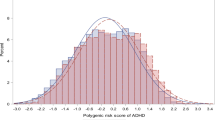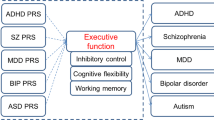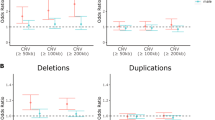Abstract
Monoamine oxidase A (MAO A) is located on the X chromosome and metabolizes biogenic amines including dopamine, norepinephrine and serotonin. A functional promoter-region polymorphism of this gene has been described that has been studied in a number of mental illnesses but not in attention deficit hyperactivity disorder (ADHD). In the current study, we examined the MAO A promoter-region polymorphism initially in 133 triads and observed preferential transmission of the long alleles from 74 heterozygote mothers to ADHD probands (χ2 = 4.37, P = 0.036, df = 1). We also examined the role of this polymorphism in a computerized continuous performance test, the TOVA. Significant differences were observed on errors of commission (χ2 = 7.021, P = 0.008) and patients carrying the long MAO A allele made significantly more such errors. Errors of commission are a measure of impulsivity. However, following Ritalin (methylphenidate) administration the association between this polymorphism and errors of commission was markedly attenuated and no longer significant at the P < 0.05 level. We also analyzed the provisional association by the case-control design. A significant difference in allele frequency was observed between 110 male probands vs 202 male controls (Pearson χ2 = 7.94, P = 0.047). Similarly results were obtained when 19 female probands were compared to female controls (genotype χ2 = 21.28; P = 0.0032, 3 df and allele χ2 = 30.88, P= 0.0007, 2 df). All three complementary approaches employed (family-based, case-control and quantitative trait design) suggest a role for the MAO A promoter-region polymorphism in conferring risk for ADHD in our patient population.
This is a preview of subscription content, access via your institution
Access options
Subscribe to this journal
Receive 12 print issues and online access
$259.00 per year
only $21.58 per issue
Buy this article
- Purchase on Springer Link
- Instant access to full article PDF
Prices may be subject to local taxes which are calculated during checkout
Similar content being viewed by others
References
Gomez R, Harvey J, Quick C, Scharer I, Harris G . DSM-IV AD/HD: confirmatory factor models, prevalence, and gender and age differences based on parent and teacher ratings of Australian primary school children J Child Psychol Psychiatry 1999 40: 265–274
Anderson JC, Williams S, McGee R, Silva PA . DSM-III disorders in preadolescent children. Prevalence in a large sample from the general population Arch Gen Psychiatry 1987 44: 69–76
Chen ZY, Powell JF, Hsu YP, Breakefield XO, Craig IW . Organization of the human monoamine oxidase genes and long-range physical mapping around them Genomics 1992 14: 75–82
Shih JC, Thompson RF . Monoamine oxidase in neuropsychiatry and behavior Am J Hum Genet 1999 65: 593–598
Nolen WA, Hoencamp E, Bouvy PF, Haffmans PM . Reversible monoamine oxidase-A inhibitors in resistant major depression Clin Neuropharmacol 1993 16: S69–S76
Baldessarini RJ . Current status of antidepressants: clinical pharmacology and therapy J Clin Psychiatry 1989 50: 117–126
Brunner HG . MAOA deficiency and abnormal behaviour: perspectives on an association Ciba Found Symp 1996 194: 155–164
Cases O et al. Aggressive behavior and altered amounts of brain serotonin and norepinephrine in mice lacking MAOA Science 1995 268: 1763–1766
Sobell JL, Lind TJ, Hebrink DD, Heston LL, Sommer SS . Screening the monoamine oxidase B gene in 100 male patients with schizophrenia: a cluster of polymorphisms in African-Americans but lack of functionally significant sequence changes Am J Med Genet 1997 74: 44–49
Mellick GD et al. The monoamine oxidase B gene GT repeat polymorphism and Parkinson's disease in a Chinese population J Neurol 2000 247: 52–55
Black GC, Chen ZY, Craig IW, Powell JF . Dinucleotide repeat polymorphism at the MAOA locus Nucleic Acids Res 1991 19: 689
Hinds HL, Hendriks RW, Craig IW, Chen ZY . Characterization of a highly polymorphic region near the first exon of the human MAOA gene containing a GT dinucleotide and a novel VNTR motif Genomics 1992 13: 896–897
Sabol SZ, Hu S, Hamer D . A functional polymorphism in the monoamine oxidase A gene promoter Hum Genet 1998 103: 273–279
Deckert J et al. Excess of high activity monoamine oxidase A gene promoter alleles in female patients with panic disorder Hum Mol Genet 1999 8: 621–624
Denney RM, Koch H, Craig IW . Association between monoamine oxidase A activity in human male skin fibroblasts and genotype of the MAOA promoter-associated variable number tandem repeat Hum Genet 1999 105: 542–551
Syagailo YV et al. Association analysis of the functional monoamine oxidase A gene promoter polymorphism in psychiatric disorders Am J Med Genet 2001 105: 168–171
Schulze TG et al. Association between a functional polymorphism in the monoamine oxidase A gene promoter and major depressive disorder Am J Med Genet 2000 96: 801–803
Jorm AF et al. Association of a functional polymorphism of the monoamine oxidase A gene promoter with personality and psychiatric symptoms Psychiatr Genet 2000 10: 87–90
Ho LW et al. Genetic associations with clinical characteristics in bipolar affective disorder and recurrent unipolar depressive disorder Am J Med Genet 2000 96: 36–42
Preisig M et al. Association between bipolar disorder and monoamine oxidase A gene polymorphisms: results of a multicenter study Am J Psychiatry 2000 157: 948–955
Manuck SB, Flory JD, Ferrell RE, Mann JJ, Muldoon MF . Aregulatory polymorphism of the monoamine oxidase-A gene may beassociated with variability in aggression, impulsivity, and centralnervous system serotonergic responsivity Psychiatry Res 2000 95: 9–23
Schmidt LG et al. Different allele distribution of a regulatory MAOA gene promoter polymorphism in antisocial and anxious-depressive alcoholics J Neural Transm 2000 107: 681–689
Samochowiec J et al. Association of a regulatory polymorphism in the promoter region of the monoamine oxidase A gene with antisocial alcoholism Psychiatry Res 1999 86: 67–72
Hamilton SP et al. No genetic linkage or association between a functional promoter polymorphism in the monoamine oxidase-A gene and panic disorder Mol Psychiatry 2000 5: 465–466
Payton A et al. Examining for association between candidate gene polymorphisms in the dopamine pathway and attention-deficit hyperactivity disorder: a family- based study Am J Med Genet 2001 105: 464–470
Jiang S et al. Association between attention deficit hyperactivity disorder and the DXS7 locus Am J Med Genet 2000 96: 289–292
Ewens WJ, Spielman RS . The transmission/disequilibrium test : history, subdivision and admixture Am J Hum Genet 1995 57: 455–464
Spielman RS, McGinnis RE, Ewans WJ . Transmission test for linkage disequilibrium: the insulin gene region and insulin-dependent diabetes mellitus (IDDM) Am J Hum Genet 1993 52: 506–516
Forbes GB . Clinical utility of the Test of Variables of Attention (TOVA) in the diagnosis of attention-deficit/hyperactivity disorder J Clin Psychol 1998 54: 461–476
Greenberg LM, Waldman ID . Developmental normative data on the test of variables of attention (T.O.V.A.) J Child Psychol Psychiatry 1993 34: 1019–1030
Gershon ES et al. Closing in on genes for manic-depressive illness and schizophrenia Neuropsychopharmacology 1998 18: 233–242
Freedman R, Adler LE, Leonard S . Alternative phenotypes for the complex genetics of schizophrenia Biol Psychiatry 1999 45: 551–558
Benjamin J, Ebstein RP, Belmaker RH . Genes for human personality traits: ‘endophenotypes’ of psychiatric disorders? World J Biol Psychiatry 2001 2: 54–57
Egan MF et al. Effect of COMT Val108/158 Met genotype on frontal lobe function and risk for schizophrenia Proc Natl Acad Sci USA 2001 98: 6917–6922
Ott J . Linkage analysis with biological markers Hum Hered 1995 45: 169–174
Conners CK . Rating scales in attention-deficit/hyperactivity disorder: use in assessment and treatment monitoring J Clin Psychiatry 1998 59 Suppl 7: 24–30
Achenbach TM, Edelbrock CS . Behavioral problems and competencies reported by parents of normal and disturbed children aged four through sixteen Monogr Soc Res Child Dev 1981 46: 1–82
Wechsler D . WISC-R Manual: Wechsler Intelligence Scale for Children—Revised Psychological Corporation: San Antonio 1974
Sham PC, Curtis D . An extended transmission/disequilibrium test (TDT) for multi-allele marker loci Ann Hum Genet 1995 59: 323–336
Ebstein RP, Benjamin J, Belmaker RH . Personality and polymorphisms of genes involved in aminergic neurotransmission Eur J Pharmacol 2000 410: 205–214
Ebstein RP, Benjamin J, Belmaker RH . Genetics of personality dimensions Curr Opin Psychiatry 2000 13: 617–622
Cardinal RN, Pennicott DR, Sugathapala CL, Robbins TW, Everitt BJ . Impulsive choice induced in rats by lesions of the nucleus accumbens core Science 2001 292: 2499–2501
Pliszka SR, McCracken JT, Maas JW . Catecholamines in attention-deficit hyperactivity disorder: current perspectives J Am Acad Child Adolesc Psychiatry 1996 35: 264–272
Volkow ND et al. Therapeutic doses of oral methylphenidate significantly increase extracellular dopamine in the human brain J Neurosci 2001 21: RC121
Jonsson EG et al. A promoter polymorphism in the monoamine oxidase A gene and its relationships to monoamine metabolite concentrations in CSF of healthy volunteers J Psychiatr Res 2000 34: 239–244
Faraone SV, Doyle AE, Mick E, Biederman J . Meta-analysis of the association between the 7-repeat allele of the dopamine D(4) receptor gene and attention deficit hyperactivity disorder Am J Psychiatry 2001 158: 1052–1057
Asghari V et al. Modulation of intracellular cyclic AMP levels by different human dopamine D4 receptor variants J Neurochem 1995 65: 1157–1165
Krause K, Dresel SH, Krause J, Kung HF, Tatsch K . Increased striatal dopamine transporter in adult patients with attention deficit hyperactivity disorder: effects of methylphenidate as measured by single photon emission computed tomography Neurosci Lett 2001 285: 107–110
Swanson JM et al. Dopamine genes and ADHD Neurosci Biobehav Rev 2000 24: 21–25
Ernst M . et al. High midbrain [18F]DOPA accumulation in children with attention deficit hyperactivity disorder Am J Psychiatry 1999 156: 1209–1215
Swanson J, Castellanos FX, Murias M, LaHoste G, Kennedy J . Cognitive neuroscience of attention deficit hyperactivity disorder and hyperkinetic disorder Curr Opin Neurobiol 1998 8: 263–271
Florin SM, Kuczenski R, Segal DS . Regional extracellular norepinephrine responses to amphetamine and cocaine and effects of clonidine pretreatment Brain Res 1994 654: 53–62
Segal DS, Kuczenski R . Escalating dose-binge treatment with methylphenidate: role of serotonin in the emergent behavioral profile J Pharmacol Exp Ther 1999 291: 19–30
Biederman J, Spencer T . Attention-deficit/hyperactivity disorder (ADHD) as a noradrenergic disorder Biol Psychiatry 1999 46: 1234–1242
Seeger G, Schloss P, Schmidt MH . Functional polymorphism within the promotor of the serotonin transporter gene is associated with severe hyperkinetic disorders Mol Psychiatry 2001 6: 235–238
Manor I et al. Family based association study of the serotonin transporter promoter-region polymorphism (5-HTTLPR) in attention deficit hyperactivity disorder (ADHD) Am J Med Genet 2001 105: 91–95
Gainetdinov RR et al. Role of serotonin in the paradoxical calming effect of psychostimulants on hyperactivity Science 1999 283: 397–401
Gainetdinov RR, Caron MG . An animal model of attention deficit hyperactivity disorder Mol Med Today 2001 6: 43–44
Gottesman II, Wolfgram DL . Schizophrenia Genesis : the Origins of Madness Freeman: New York 1991 p 296
Schuckit MA . Genetics of the risk for alcoholism Am J Addict 2000 9: 103–112
Chen WJ, Faraone SV . Sustained attention deficits as markers of genetic susceptibility to schizophrenia Am J Med Genet 2000 97: 52–57
Curran S et al. QTL association analysis of the DRD4 exon 3 VNTR polymorphism in a population sample of children screened with a parent rating scale for ADHD symptoms Am J Med Genet 2001 105: 387–393
Leboyer M et al. Psychiatric genetics: search for phenotypes Trends Neurosci 1998 21: 102–105
Cornblatt BA, Malhotra AK . Impaired attention as an endophenotype for molecular genetic studies of schizophrenia Am J Med Genet 2001 105: 11–15
Cannon TD, Gasperoni TL, van Erp TG, Rosso IM . Quantitative neural indicators of liability to schizophrenia: implications for molecular genetic studies Am J Med Genet 2001 105: 16–19
Acknowledgements
This research was supported by a grant from the Israeli Ministry of Health.
Author information
Authors and Affiliations
Corresponding author
Additional information
Beersheva Mental Health Center, Faculty of Health Sciences, Ben-Gurion University of the Negev, Israel
Rights and permissions
About this article
Cite this article
Manor, I., Tyano, S., Mel, E. et al. Family-based and association studies of monoamine oxidase A and attention deficit hyperactivity disorder (ADHD): preferential transmission of the long promoter-region repeat and its association with impaired performance on a continuous performance test (TOVA). Mol Psychiatry 7, 626–632 (2002). https://doi.org/10.1038/sj.mp.4001037
Received:
Revised:
Accepted:
Published:
Issue Date:
DOI: https://doi.org/10.1038/sj.mp.4001037
Keywords
This article is cited by
-
Evidence for anti-inflammatory effects and modulation of neurotransmitter metabolism by Salvia officinalis L.
BMC Complementary Medicine and Therapies (2022)
-
Pilot study indicate role of preferentially transmitted monoamine oxidase gene variants in behavioral problems of male ADHD probands
BMC Medical Genetics (2017)
-
Regional cortical thinning of the orbitofrontal cortex in medication-naïve female patients with major depressive disorder is not associated with MAOA-uVNTR polymorphism
Annals of General Psychiatry (2016)
-
ADHD risk alleles associated with opiate addiction: study of addicted parents and their children
Pediatric Research (2016)
-
ADHD History of the Concept: the Case of the Continuous Performance Test
Current Developmental Disorders Reports (2015)



